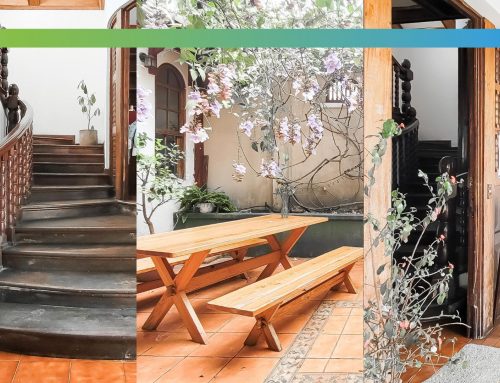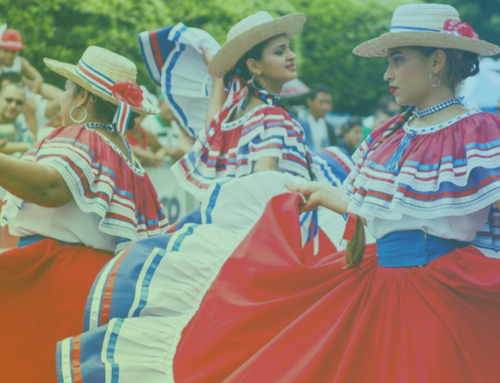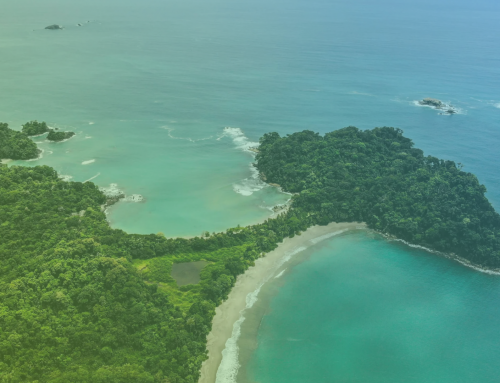Costa Rica is one of the countries that due to its biodiversity has a great variety in avifauna, in our country there are more than 920 species of birds registered, including the continental and maritime territory. Cartago, is one of the places, which contributes more species to this great accounting of birds, in recent censuses, about 600 species have been found in this province. That is why, if you want to birding, Cartago is your best option. If you want to observe birds, spend time surrounded by their interesting sounds, do not hesitate to live in this region.
From the urban areas of Cartago, to the most forested areas, between 600 and 3000m of elevation, are the routes that surround a world of interesting birds.
Cartago’s features that attract avifauna:
The geography of Cartago is very diverse so many species of birds, both endemic and migratory are located in this city to be observed and admired by different visitors. The topography has abundant variables, there are from mountain to flatter parts like Turrialba.
It contains forests, wetlands, lagoons and rivers; it has cloud forests near like El Guarco, Tapantí and the Irazú Volcano. It also stands out the paramo in the highest part of the volcano whose vegetation is stunted and dry, small and rough. So all this combination of life zones together with the difference of climates, from humid to warm in the center of the province makes it the cradle of many species of birds.
One of the great advantages is that make a better place to the avifauna to live, but it also attracts people interested in moving to this territory.
What are the most attractive birds you will find living in Cartago?
Daniel Martínez, ornithologist and birding guide, made a list of the most relevant and attractive bird species found in the province.
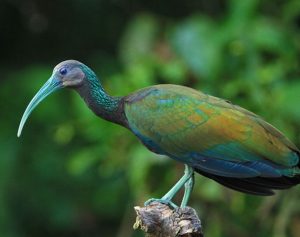
Mesembrinibis cayennensis: Its common name in Costa Rica is Green Ibis. It has a medium size, with short legs and a long, thin and curved bill. Males are usually larger.
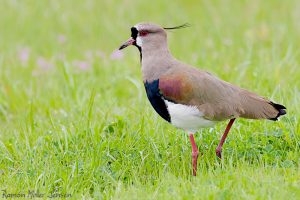
Vanellus chilensis: Known in Costa Rica as Southern Lapwing. It has a small and fine tuft, with black plumage with a mixture of white, gray and brown. It may have purplish tones on the wing. The head is gray with white edges near the eye and bill. The bill is white and red with a black tip.
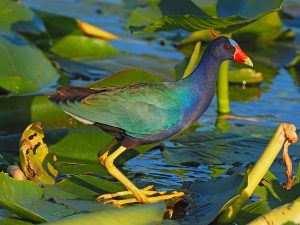
Porphyrio martinica: In Costa Rica is knows as Purple Gallinule. It is of medium size, unmistakable with its large yellow legs, bluish purple plumage with green on the back. Its beak is red and yellow. It has a pale blue front shield with white underparts.
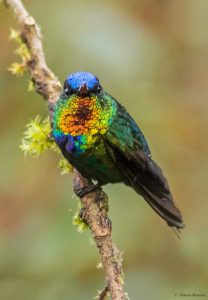
Panterpe insignis: Its common name in Costa Rica is Fiery-throated Hummingbird. It is 11 cm long and weighs 5.7 g. It has a straight black bill and dark legs, with bright green plumage on the body, blue tail and a white spot behind the eye. When the light hits it at the right angle, a bright blue crown is visible, a bright yellow bordering its orange throat and a blue patch on the chest.
More birds are
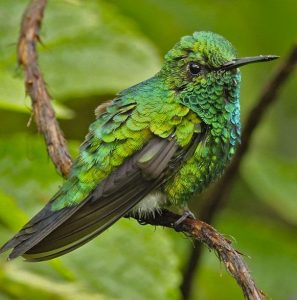
Chlorostilbon assimilis: Commonly known as Garden Emerald. It is 8 cm long and weighs 2.6 g. The male’s upperparts are tan and the underparts are bright green, with white rumps and a very forked tail. While the female has gray underparts, with a white stripe behind the eye and spots on the ears. The tail has white tips, deep forked design of the male’s tail.
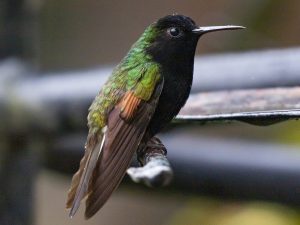
Eupherusa nigriventris: Its common name in Costa Rica is Black-bellied Hummingbird. It is a small and distinctive hummingbird. Males have mostly black body plumage and bright white outer tail feathers, which is a combination unlike any other hummingbird species. While the female is mostly whitish rather than black. It has extensive white on its tail and a small reddish-brown patch on the wing.
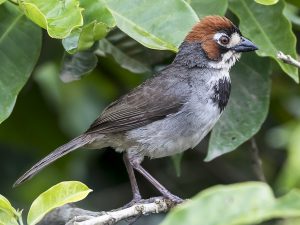
Melozone cabanisi: Known as Cabanis’s Ground-Sparrow. It has olive-brown upperparts and mainly white underparts. It has a reddish crown and cheeks, both joined behind the white spot surrounding the eyes. Its forehead is black and the lower edge of the white lorum is also black. It also has black malar stripes contrasting with the white throat and a rounded black spot in the center of the chest.

Microchera albocoronata: Known in Costa Rica as Snowcap. Adult males are unmistakable, they have a bright white crown, dark purple body with white outer tail feathers. The adult female is bronze green on top and pale white on the underside and outer tail feathers. Juvenile birds resemble the females, but duller.
Other birds are:
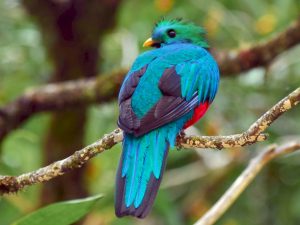
Pharomachrus mocinno: Its common name in Costa Rica is Resplendent Quetzal, which cannot fly very fast. Males have a plumage on the body that is iridescent green, with reflections that vary from gold to blue-violet. Its chest and belly are deep crimson red. The bill has partially green filamentous feathers, yellow in males and black in females. The female legs are dark and short, with the first two toes backwards. The colors are more modest, their feathers have dark spots with red breast. Its tail is shorter and the head is brownish brown.

Tangara dowii: Its common name in Costa Rica is Spangle-cheeked Tanager. Adults measure 13 cm in length and weigh 20 g. Their head is black, the back and chest have a blue scaly color. The sides of the face, neck, and a patch on the crown are reddish. The wings and tail have blue trim, the rump is green and the belly is cinnamon.
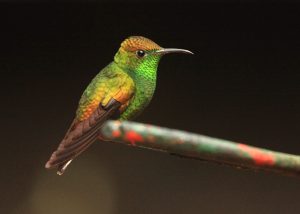
Elvira cupreiceps: Known as Coppery-Headed Emerald. The male has a copper crown and rump and a green belly. The female has a white belly and a narrow black subterminal band on the white outer rectrices of the tail. Its bill is noticeably curved downward, which distinguishes it from the white-tailed emerald.
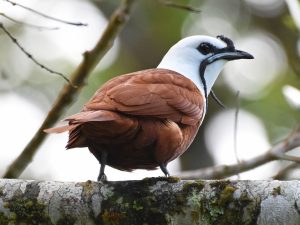
Procnias tricarunculatus: Its common name in Costa Rica is Three-wattled Bellbird. The plumage of the male is bright rufous reddish brown, and the head, neck, nape and upper back and chest are white. Around the eyes there is a blackish stripe. It has three long wattles hanging from its bill. The female is smaller and has no beard. Its back plumage is olive, with yellowish margins on the feathers.
Specialized places in Cartago for birding
The specialist, Daniel Martínez, also mentioned the ideal places for birdwatching. And some recommendations to take into account during the activity.
Near Paraíso de Cartago there are very good places to see birds such as Tapantí, Hotel Quelitales that is known as an ideal destination to see hummingbirds. In the area of Birrisito, where there are predominantly farms that are appropriate places for this activity. There are many of these private farms that maintain trails and also have small restaurants, with a more local type of tourism.
There are also public trails near Ujarrás especially for this. The area of Navarro and the Hotel Río Perlas are not to be missed. Another tourist place dedicated to birding is the park La Expresión-Laguna Doña Ana Cleto, which belongs to ICODER, and is very popular for watching waterfowl mainly. Other places are the Río Macho Forest Reserve, the La Marta Wildlife Refuge and the UCR University Campus in Paraíso.
Recommendations for birding
When planning to go birding, some tips should be taken into account so the activity could be friendly with the species but without endangering them and to us it could be the full experience.
Cartago has wonders that make its surroundings the cradle of bird species that are visually incredible to our eyes, and not by chance, Costa Rica is the fifth place in the world as a favorite place for bird watching and Cartago has more than half of the bird population of the country. But its proximity to the city of San Jose and the variety of sites from public roads, farms, and hotels that make Cartago a place of total accessibility for birding. Your next trip should undoubtedly be to experience this birding sensation. You con contact Daniel Martínez (jacamerops@yahoo.com) to book a birding tour.
Being in contact with nature just by opening the door of my house is something I really value. Having the possibility every morning to observe hummingbirds of all sizes and colors that come to the garden for the nectar of the flowers fills my life with gratitude, optimism and admiration.



